



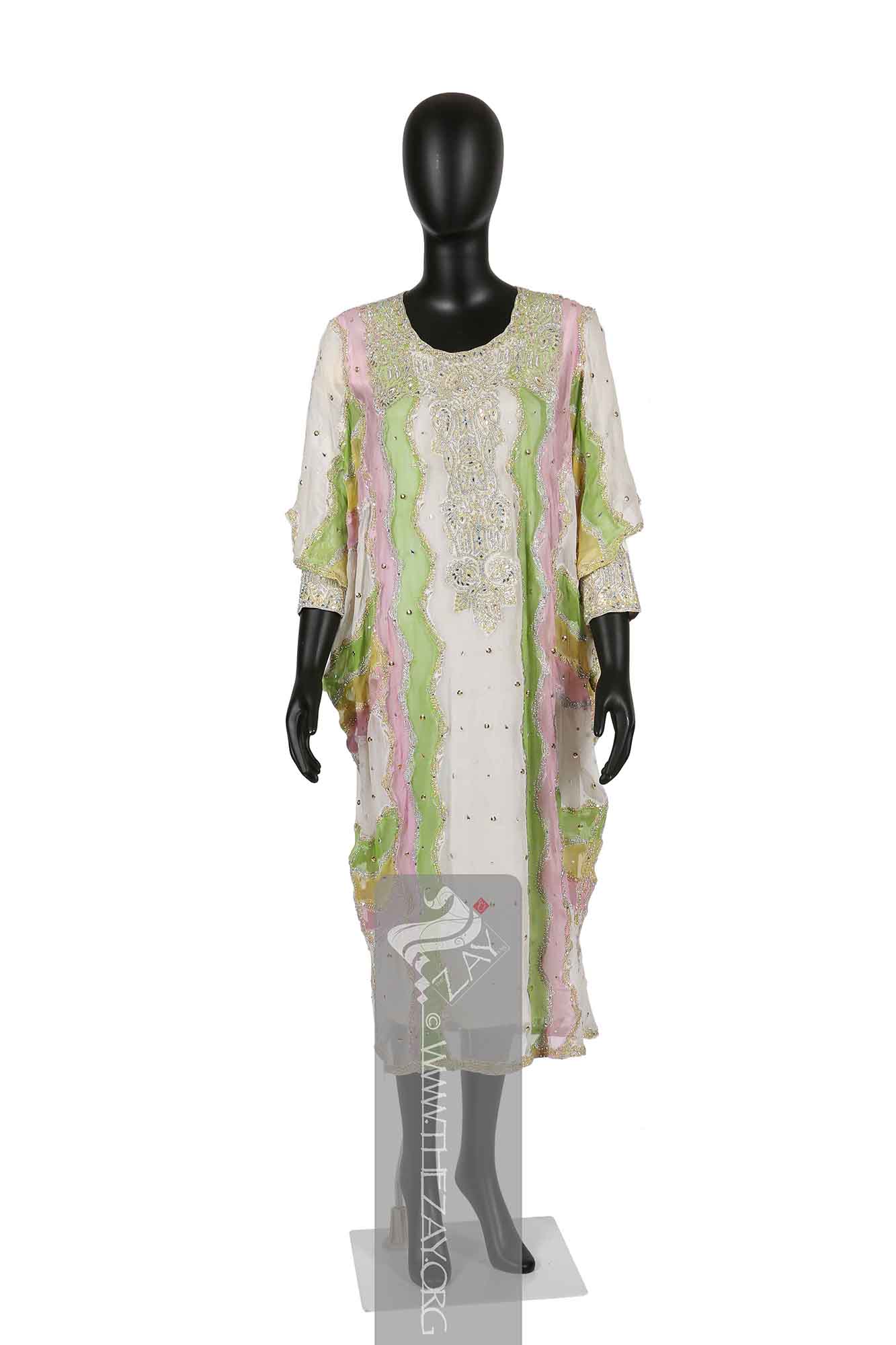

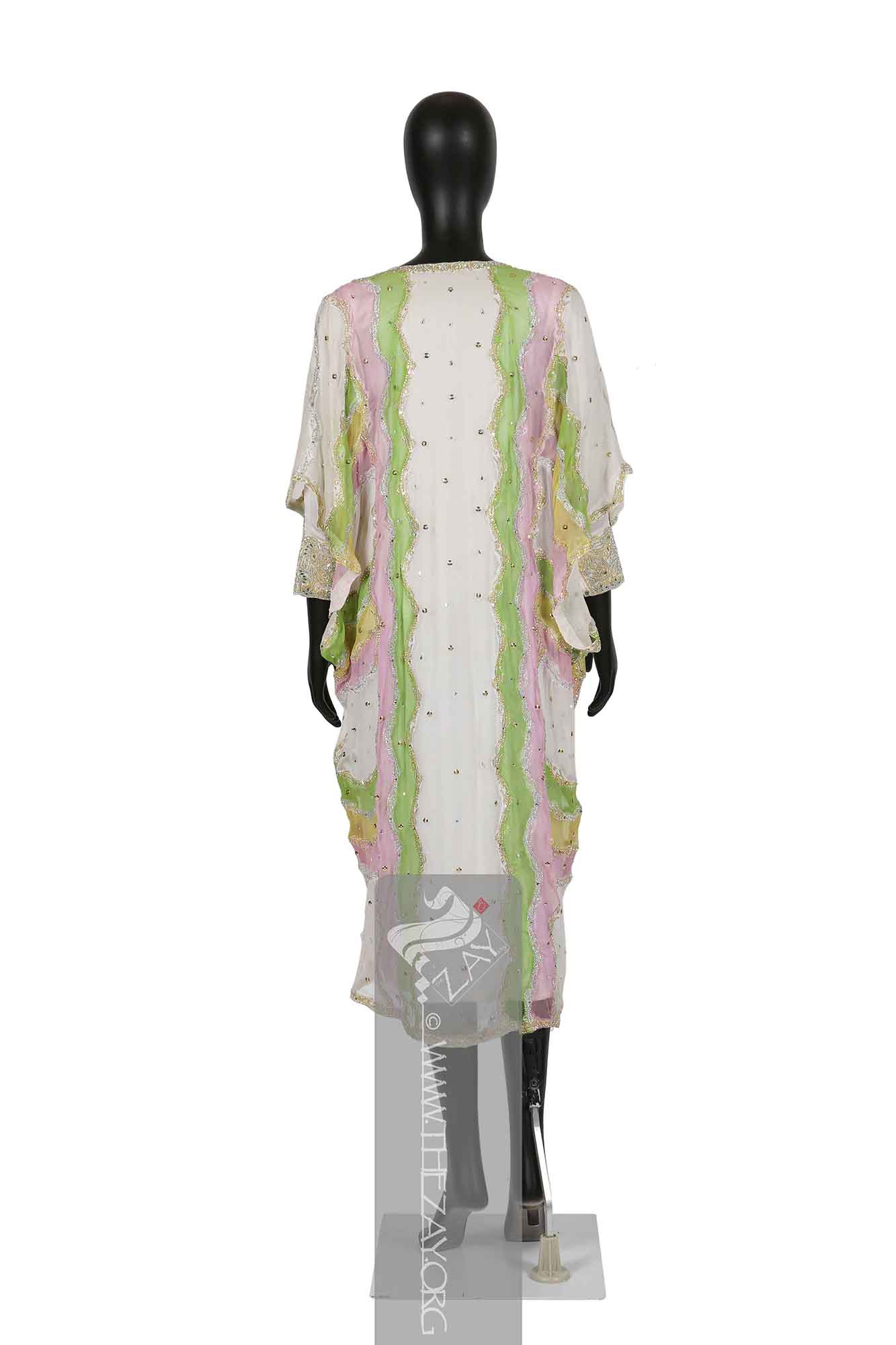
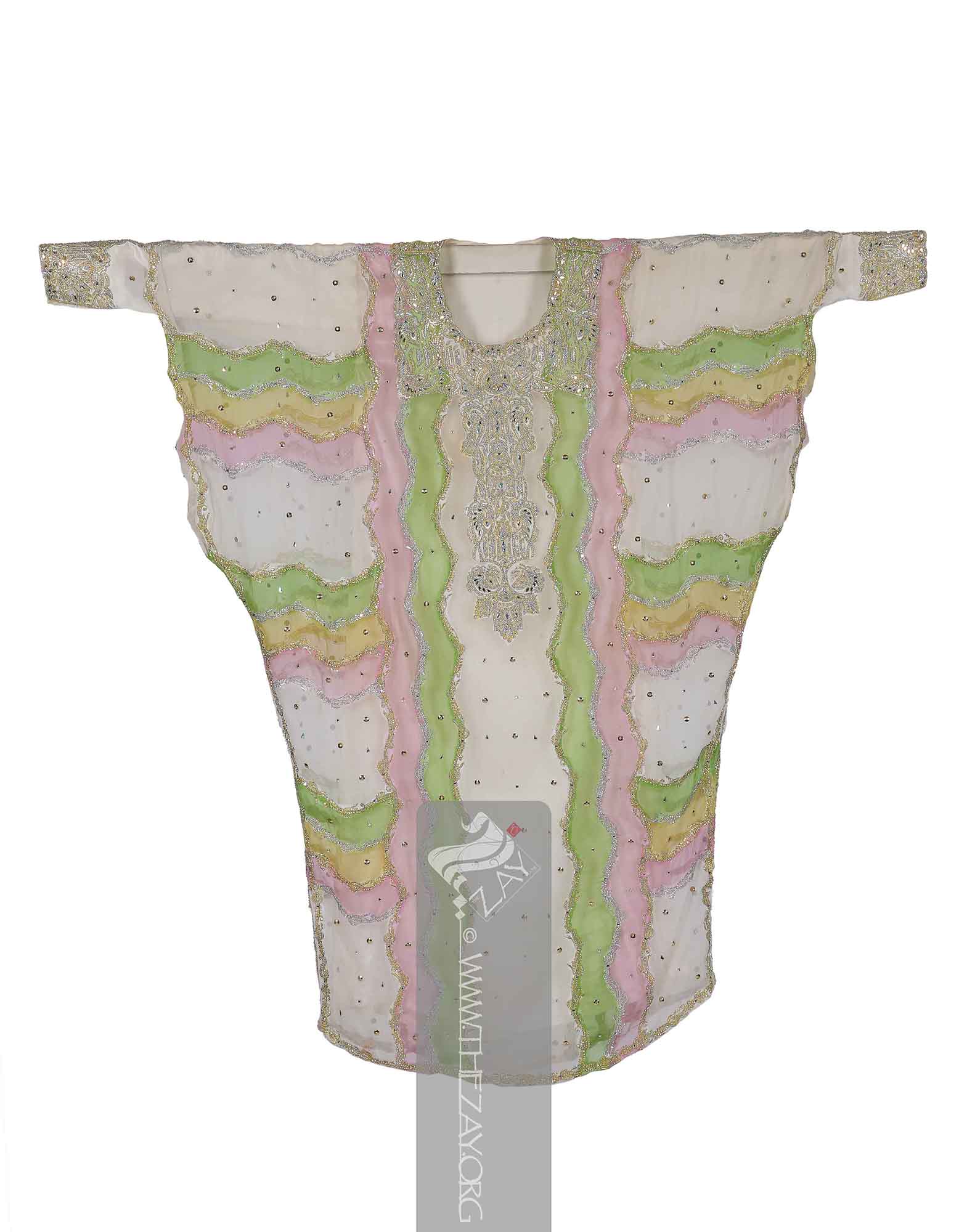
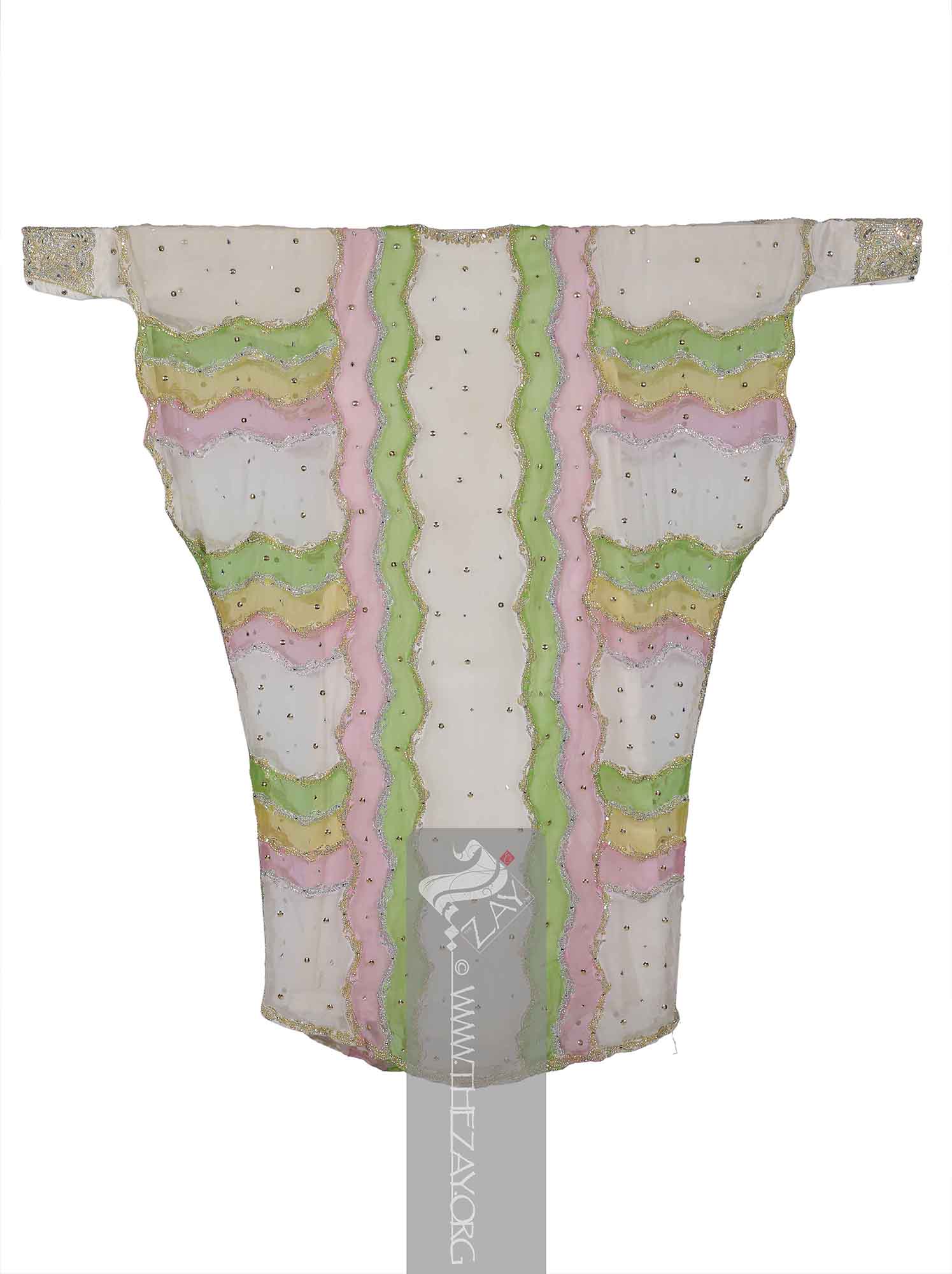
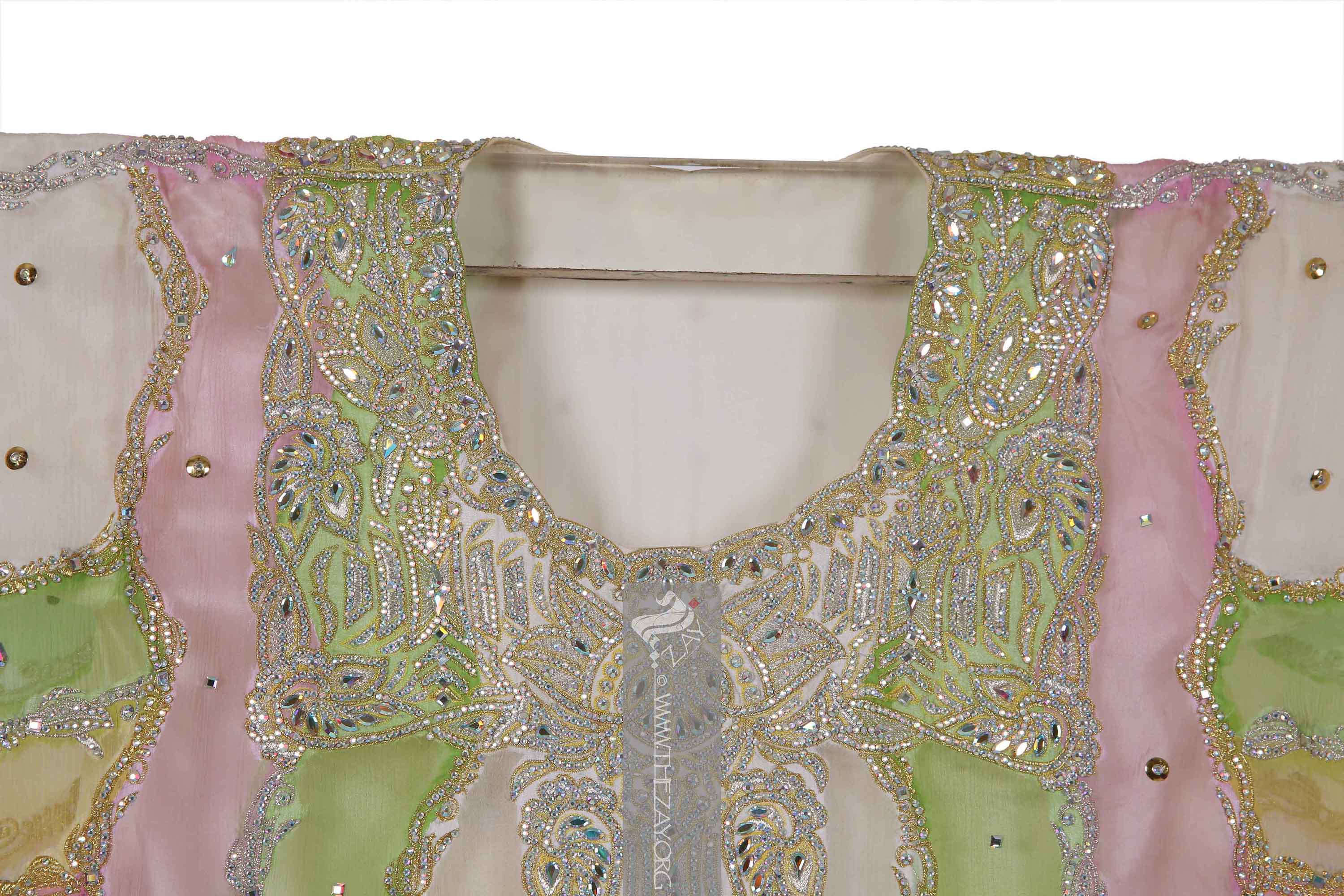

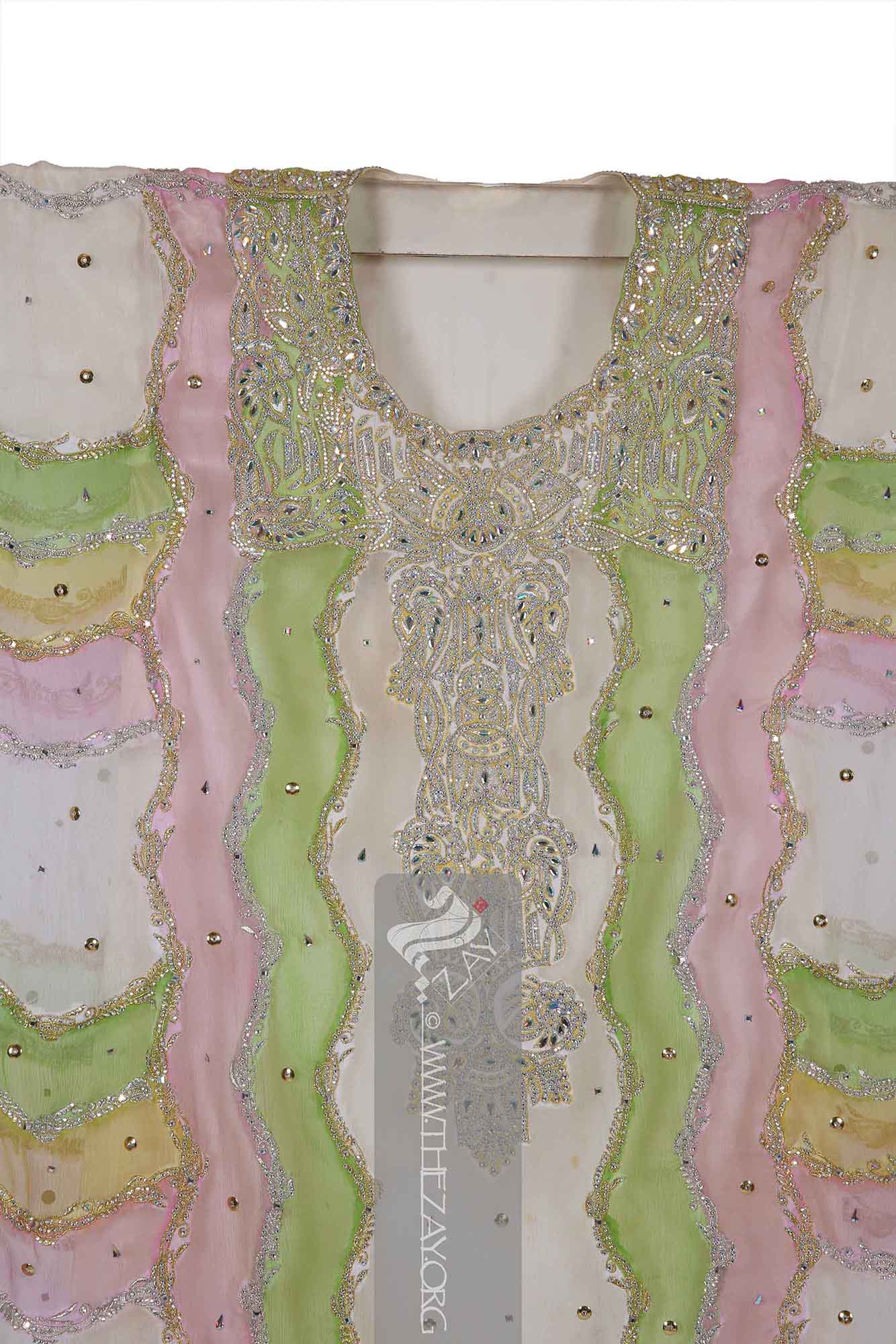
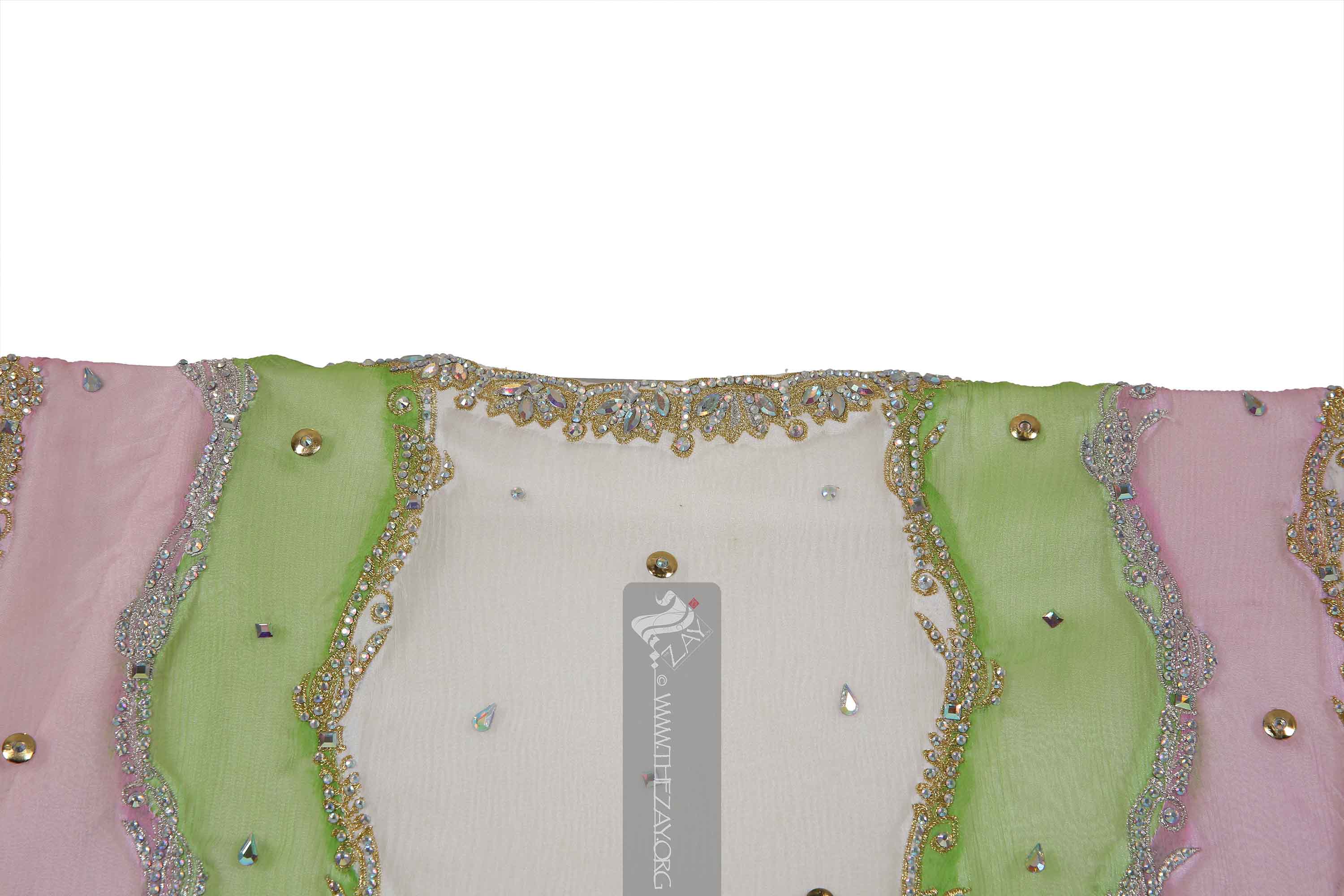
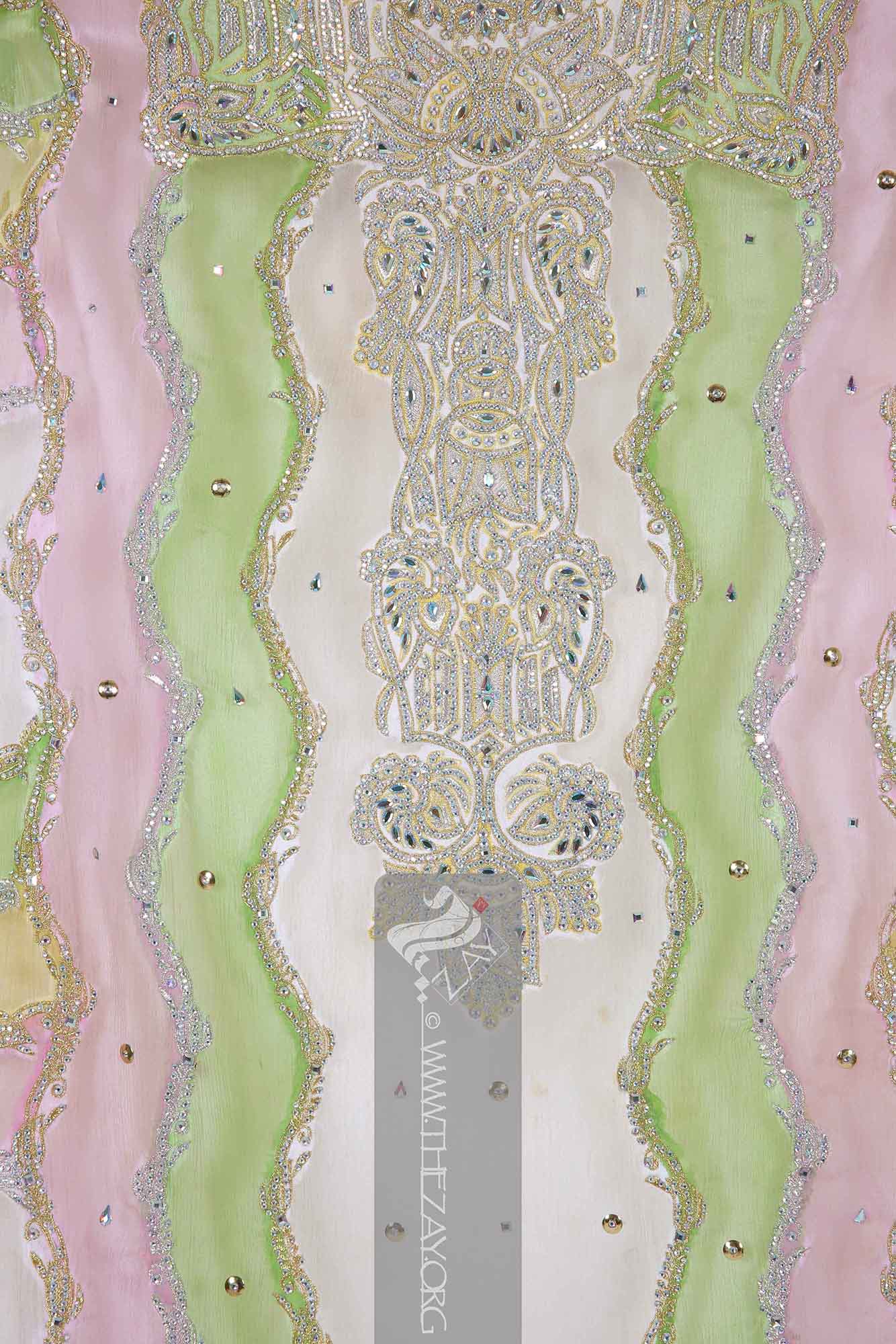
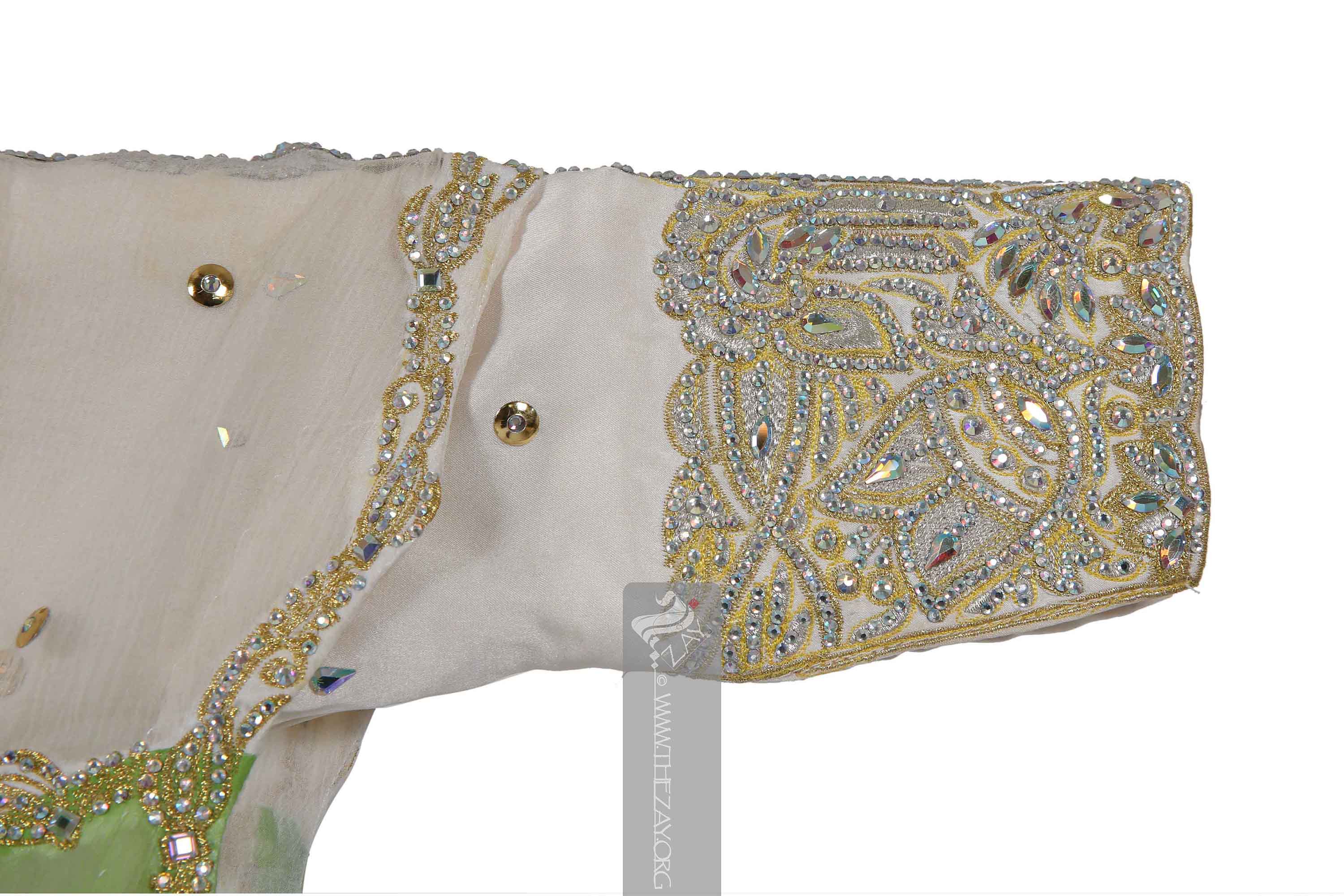
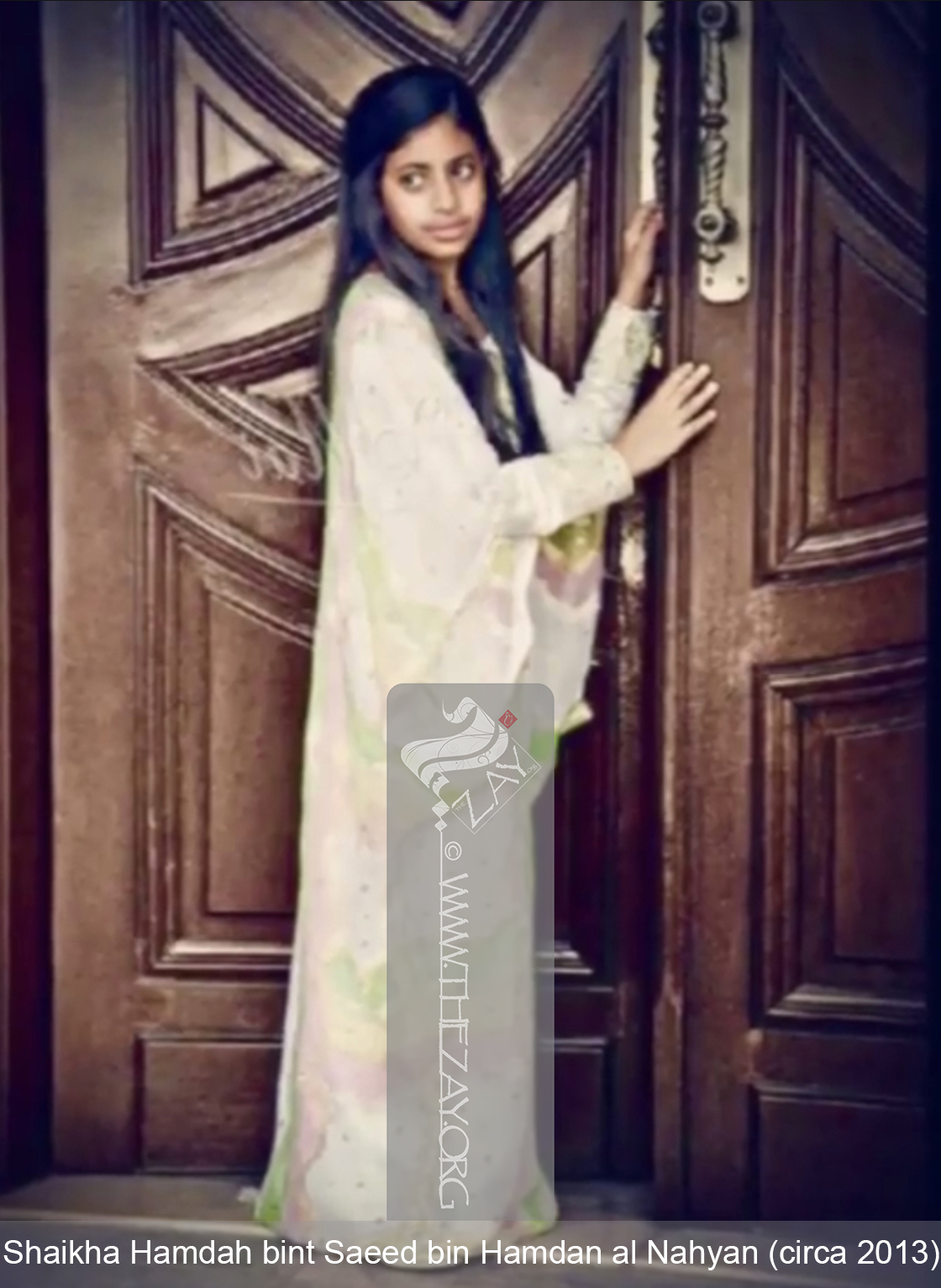
| Local Name | Thawb_kandurah myaza’ |
| Object Category | Combination overgarment tunic Other |
| Gender | Female |
| Date of object | 2013 |
| Place Of orgin | United Arab Emirates |
| Region | Abu Dhabi |
| Object Range | UAE, Oman |
| Dimensions | Length: 118 cm Width: 125 cm |
| Materials | Silk |
| Technique | Machine Embroidered Machine Stitched Embellished |
| Color | |
| Motif | Arabesque |
| Provenance | Gifted, shaikha Shaikha bint Mohammed Al Nahyan, Abu Dhabi 2013 |
| Location | Zeman Awwal, Mall of the Emirates |
| Status | On Display |
| ZI number | ZI2013.500181 UAE |
Ṭariq: (Arabic; Synonym: tulle_bi_talli; talli; badla; khus_dozi ), series of small metal knots made on a woven net ground as embellishment. The term is commonly used in the Levant Arab region specifically in Lebanon.
el Mutwalli Dr. Reem TariqṬariq: (Arabic; Synonym: tulle_bi_talli; talli; badla; khus_dozi ), series of small metal knots made on a woven net ground as embellishment. The term is commonly used in the Levant Arab region specifically in Lebanon.
el Mutwallī: Founder (CEO) of the Zay Zay: (Arabic: costume, Pl. azyaā’), a set of clothes in a style typical of a particular country or historical period. Initiative, a public figure, speaker and author. An expert curator and consultant in Islamic art and architecture, interior design, historic costume, and UAE heritage. and was eventually added to The Zay Zay: (Arabic: costume, Pl. azyaā’), a set of clothes in a style typical of a particular country or historical period. Collection.Qamīṣ: (Possibly late Latin: Camisia – Linen Undergarment; Synonym: Kamiz), a traditional loose fitting long tunic or shirt worn by both men and women in South and Central Asia and the Arab world. Typically extending below the waist it is usually paired with a pair of trousers.
) tunic with frontal neckline opening, worn by both sexes. Each Arab region has a different term for what is essentially a similar garment with various small differences., qandurah Qandūrah: (Arabic, pl. qanādīr, synonyms: ghandurah Ghandūrah: (Arabic, pl. qanādīr, synonyms: qandurah, darā’ah, dishdāshah, jalābah, jallābīyah, qaftan, mqta’, thawb or tobe), a loose, short or long-sleeved, shirt like (qamisQamīṣ: (Possibly late Latin: Camisia – Linen Undergarment; Synonym: Kamiz), a traditional loose fitting long tunic or shirt worn by both men and women in South and Central Asia and the Arab world. Typically extending below the waist it is usually paired with a pair of trousers.
) tunic with frontal neckline opening, worn by both sexes. Each Arab region has a different term for what is essentially a similar garment with various small differences., darā’ah, dishdāshah, jalābah, jallābīyah, qaftan, mqta’, thawb or tobe Tobe: (Arabic: thawb, Pl. Athwāb/thībān), can be pronounced thawb or thobe based on locale. The standard Arabic word for ‘fabric’ or ‘garment’. It can refer to a qamīs-like tunic worn by men and women in the Arabian Peninsula, Iraq, the southern and south-western ports and islands of Iran, and some countries in East and West Africa. More specifically, it can refer to the square-shaped Bedouin overgarment worn by women. ), a loose, short or long-sleeved, shirt like (qamisQamīṣ: (Possibly late Latin: Camisia – Linen Undergarment; Synonym: Kamiz), a traditional loose fitting long tunic or shirt worn by both men and women in South and Central Asia and the Arab world. Typically extending below the waist it is usually paired with a pair of trousers.
) tunic with frontal neckline opening, worn by both sexes. Each Arab region has a different term for what is essentially a similar garment with various small differences. , dra’ah, dishdāshah, jallābīyah, jalābah, jillābīyah, qaftan, mqta’, thawb or tobe Tobe: (Arabic: thawb, Pl. Athwāb/thībān), can be pronounced thawb or thobe based on locale. The standard Arabic word for ‘fabric’ or ‘garment’. It can refer to a qamīs-like tunic worn by men and women in the Arabian Peninsula, Iraq, the southern and south-western ports and islands of Iran, and some countries in East and West Africa. More specifically, it can refer to the square-shaped Bedouin overgarment worn by women. ) loose, short or long sleeved, shirt like (qamisQamīṣ: (Possibly late Latin: Camisia – Linen Undergarment; Synonym: Kamiz), a traditional loose fitting long tunic or shirt worn by both men and women in South and Central Asia and the Arab world. Typically extending below the waist it is usually paired with a pair of trousers.
) tunic with frontal neckline opening, worn by both sexes. Each Arab region has a different term for what is essentially a similar garment with various small differences.). Soon this evolved into a matching set known as (thawb_wa_kandurah Thawb_wa_kandūrah: (colloquial, UAE), an elaborate form of the traditional overgarment (thawb Thawb: (Arabic: thawb, Pl. Athwāb/thībān), can be pronounced thobe Thobe: (Arabic: thawb, Pl. Athwāb/thībān), can be pronounced thawb or tobe Tobe: (Arabic: thawb, Pl. Athwāb/thībān), can be pronounced thawb or thobe based on locale. The standard Arabic word for ‘fabric’ or ‘garment’. It can refer to a qamīs-like tunic worn by men and women in the Arabian Peninsula, Iraq, the southern and south-western ports and islands of Iran, and some countries in East and West Africa. More specifically, it can refer to the square-shaped Bedouin overgarment worn by women. based on locale. The standard Arabic word for ‘fabric’ or ‘garment’. It can also refer to a qamīs-like tunic worn by men and women in the Arabian Peninsula, Iraq, the southern and south-western ports and islands of Iran, and some countries in East and West Africa. More specifically, it can refer to the square-shaped Bedouin overgarment worn by women. or tobe Tobe: (Arabic: thawb, Pl. Athwāb/thībān), can be pronounced thawb or thobe based on locale. The standard Arabic word for ‘fabric’ or ‘garment’. It can refer to a qamīs-like tunic worn by men and women in the Arabian Peninsula, Iraq, the southern and south-western ports and islands of Iran, and some countries in East and West Africa. More specifically, it can refer to the square-shaped Bedouin overgarment worn by women. based on locale. The standard Arabic word for ‘fabric’ or ‘garment’. It can also refer to a qamīs-like tunic worn by men and women in the Arabian Peninsula, Iraq, the southern and south-western ports and islands of Iran, and some countries in East and West Africa. More specifically, it can refer to the square-shaped Bedouin overgarment worn by women in the Arabian Gulf region. ) and tunic (kandūrah) ensemble, that evolved post-1980s where the two garments became matched as a set.). By the 1990s, it developed further, as the two pieces were merged into one, attached at the neckline to become a combination overgarment tunic called (thawb_kandurah Thawb_kandūrah: (colloquial, UAE), post-1990s the (Thawb_wa_kandūrah) ensemble of the eighties evolved where the overgarment (thawb) and tunic (kandūrah) became united at the neckline creating one outfit and inner tunic receding to act as lining.) reserved for social events.Qamīṣ: (Possibly late Latin: Camisia – Linen Undergarment; Synonym: Kamiz), a traditional loose fitting long tunic or shirt worn by both men and women in South and Central Asia and the Arab world. Typically extending below the waist it is usually paired with a pair of trousers.
) tunic with frontal neckline opening, worn by both sexes. Each Arab region has a different term for what is essentially a similar garment with various small differences., qandurah Qandūrah: (Arabic, pl. qanādīr, synonyms: ghandurah Ghandūrah: (Arabic, pl. qanādīr, synonyms: qandurah, darā’ah, dishdāshah, jalābah, jallābīyah, qaftan, mqta’, thawb or tobe), a loose, short or long-sleeved, shirt like (qamisQamīṣ: (Possibly late Latin: Camisia – Linen Undergarment; Synonym: Kamiz), a traditional loose fitting long tunic or shirt worn by both men and women in South and Central Asia and the Arab world. Typically extending below the waist it is usually paired with a pair of trousers.
) tunic with frontal neckline opening, worn by both sexes. Each Arab region has a different term for what is essentially a similar garment with various small differences., darā’ah, dishdāshah, jalābah, jallābīyah, qaftan, mqta’, thawb or tobe Tobe: (Arabic: thawb, Pl. Athwāb/thībān), can be pronounced thawb or thobe based on locale. The standard Arabic word for ‘fabric’ or ‘garment’. It can refer to a qamīs-like tunic worn by men and women in the Arabian Peninsula, Iraq, the southern and south-western ports and islands of Iran, and some countries in East and West Africa. More specifically, it can refer to the square-shaped Bedouin overgarment worn by women. ), a loose, short or long-sleeved, shirt like (qamisQamīṣ: (Possibly late Latin: Camisia – Linen Undergarment; Synonym: Kamiz), a traditional loose fitting long tunic or shirt worn by both men and women in South and Central Asia and the Arab world. Typically extending below the waist it is usually paired with a pair of trousers.
) tunic with frontal neckline opening, worn by both sexes. Each Arab region has a different term for what is essentially a similar garment with various small differences. , dra’ah, dishdāshah, jallābīyah, jalābah, jillābīyah, qaftan, mqta’, thawb or tobe Tobe: (Arabic: thawb, Pl. Athwāb/thībān), can be pronounced thawb or thobe based on locale. The standard Arabic word for ‘fabric’ or ‘garment’. It can refer to a qamīs-like tunic worn by men and women in the Arabian Peninsula, Iraq, the southern and south-western ports and islands of Iran, and some countries in East and West Africa. More specifically, it can refer to the square-shaped Bedouin overgarment worn by women. ) loose, short or long sleeved, shirt like (qamisQamīṣ: (Possibly late Latin: Camisia – Linen Undergarment; Synonym: Kamiz), a traditional loose fitting long tunic or shirt worn by both men and women in South and Central Asia and the Arab world. Typically extending below the waist it is usually paired with a pair of trousers.
) tunic with frontal neckline opening, worn by both sexes. Each Arab region has a different term for what is essentially a similar garment with various small differences.). The embroidery is then further accentuated with Swarovski iron-on crystals (fsus Fṣūṣ: (Arabic, sing. fuṣ), meaning a crystal or a bead used in embellishment or jewellery. ).